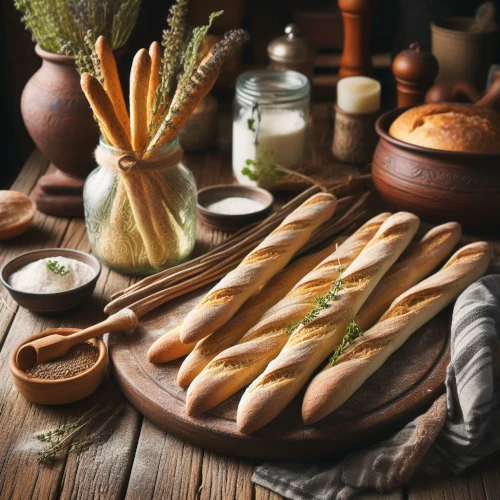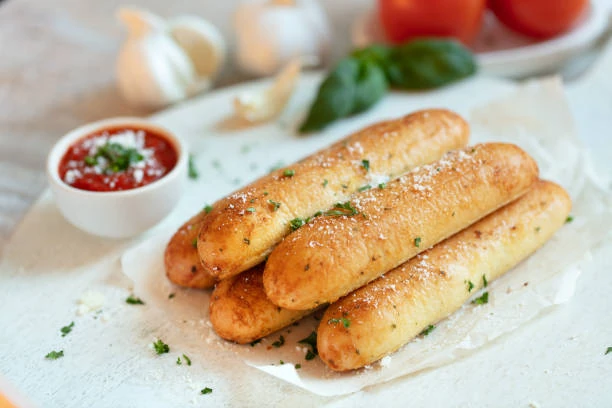Homemade Sourdough Breadsticks

Discover the art of crafting mouthwatering sourdough breadsticks from scratch with our step-by-step recipe guide. Delight in the satisfying process of mixing, kneading, and shaping the dough, resulting in irresistibly soft, chewy breadsticks that are guaranteed to tantalize your taste buds. Baked to golden perfection, these breadsticks boast a delightful combination of rustic flavor and subtle tanginess, courtesy of the active, bubbly sourdough starter. With each bite, savor the aromatic notes of freshly baked bread and relish the joy of homemade goodness. Versatile and suitable for any gathering, whether it's a cozy family meal or a festive celebration, these sourdough breadsticks will elevate any occasion with their delectable presence. Embrace the simplicity and satisfaction of baking your own breadsticks, and embark on a culinary journey that brings warmth, comfort, and the distinct pleasure of homemade perfection to your table.

Ingredients
½ cup active, bubbly sourdough starter ¾ cup water 1½ tablespoons sugar or honey 1½ teaspoons salt ¼ cup butter, softened 2½-3 cups unbleached all-purpose flour 1½ tablespoons butter, melted (for brushing) Coarse salt and garlic powder for sprinkling
Method
- 1. Add the sourdough starter, water, sugar or honey, salt, softened butter, and 2½ cups of flour to the bowl of a stand mixer fitted with a dough hook. Mix until a smooth dough forms. Gradually add flour ⅛ cup at a time as needed until the dough begins to pull away from the bottom and sides of the mixer. Don't add too much flour.
- 2. Continue kneading on low speed for 8 minutes. The dough should be smooth and elastic.
- 3. Lightly oil a large lidded glass bowl and transfer the dough to the bowl. Cover loosely with the lid and allow it to ferment at room temperature for 8-12 hours, or until it has nearly doubled in size.
- 4. Turn out the dough onto a large, lightly floured cutting board. Roll it into a 12x7-inch rectangle.
- 5. Use a pizza cutter to slice the rectangle into 12 even breadsticks. Transfer the breadsticks to a parchment-lined half sheet pan, leaving space between each one.
- 6. Cover the pan with plastic wrap and allow the breadsticks to proof in a warm place (75°-80°F) for 1-2 hours, or until they look "poofy." Meanwhile, preheat the oven to 400°F.
- 7. Remove the plastic wrap from the pan, and bake the breadsticks on the center rack for 10 minutes or until they are very lightly golden.
- 8. Use a pastry brush to brush the hot breadsticks with the melted butter. Immediately sprinkle them with coarse salt and garlic powder to taste.
- 9. Serve the breadsticks warm, or allow them to cool completely before freezing them in an airtight container.

Sourdough Breadsticks: A Delicious Taste of Tradition

Crispy, tangy, and bursting with flavor, sourdough breadsticks are a true delight for bread lovers everywhere. These slender, golden-brown beauties are a fusion of two iconic bread traditions: the ancient art of sourdough fermentation and the Italian grissini breadstick. The result is a unique and unforgettable snack or accompaniment that will transport your taste buds on a journey through history.
The History of Sourdough Breadsticks
Sourdough breadsticks, like their cousin the sourdough bread loaf, have a rich heritage that dates back to ancient civilizations. The sourdough process involves fermenting dough using naturally occurring lactobacilli and wild yeast, resulting in a bread product with a distinctive tangy flavor and chewy texture.
Breadsticks, on the other hand, trace their roots to the 17th century in the Piedmont region of northern Italy. According to a well-known legend, a local baker in the town of Turin created long, thin breadsticks for Victor Amadeus II, the young Duke of Savoy. Victor Amadeus had a delicate constitution and struggled to digest most foods due to a medical condition.
Seeking to cater to the duke's dietary needs, the resourceful baker crafted crispy, pencil-thin breadsticks that would be easy on the duke's sensitive digestive system. These breadsticks, known as grissini or "little sticks" in Italian, were an instant success. Victor Amadeus found them not only palatable but also enjoyable, and they quickly became a staple in the royal court.
The invention of grissini was a culinary breakthrough that soon spread throughout the Piedmont region and eventually across Italy. Bakers in Turin and the surrounding areas began producing their own versions of these crisp, slender breadsticks, each putting their own spin on the recipe while maintaining the characteristic long, thin shape.
As the grissini gained popularity, they evolved from a specialized dietary item for the nobility into a beloved snack and accompaniment for all social classes. Italian households would serve grissini alongside soups, salads, and other dishes, or enjoy them as a simple yet satisfying snack on their own.
Today, these grissini, or breadsticks as they are commonly known, remain an iconic part of Italian cuisine and culture. Their creation for the Duke of Savoy in the 17th century not only catered to a noble's dietary needs but also gave birth to a culinary tradition that has endured for centuries and continues to delight bread lovers around the world.
Granny's Sourdough Breadsticks Recipe: A Fusion of Flavors
Combining the ancient method of sourdough fermentation with the Italian tradition of breadsticks results in a unique and flavorful twist on two classic bread items. Granny's recipe for sourdough breadsticks is a testament to this fusion of techniques and traditions. The recipe involves a long fermentation period, allowing the flavors to develop fully and creating a breadstick that is tangy, chewy, and absolutely delicious.
One of the best things about Granny's sourdough breadsticks is their versatility. The recipe includes a method for adding various toppings, allowing you to customize the breadsticks to your taste. Whether you prefer them plain, sprinkled with coarse salt, or dusted with garlic powder, these breadsticks are a versatile addition to any meal or snack.
Tips for Sourdough Breadstick Success
As with all sourdough recipes, the key to success with sourdough breadsticks is a lively, active sourdough starter. This ingredient is what gives the breadsticks their characteristic tang and chew. If you're new to sourdough baking, be sure to give your starter plenty of time to become active before you begin this recipe.
Another important tip is to roll the breadsticks as thin as possible. This will ensure they bake up crispy and delicious. And don't forget to score the tops before baking – this will create those signature breadstick ridges that make them so irresistible.
Enjoy the Tradition of Homemade Sourdough Breadsticks
In the spirit of Granny's love for sharing and preserving culinary traditions, we invite you to try your hand at these sourdough breadsticks. Enjoy the process of crafting them from scratch and the satisfaction of enjoying your homemade creation. Whether you serve them as a snack, an appetizer, or alongside a hearty meal, these sourdough breadsticks are sure to become a new family favorite.